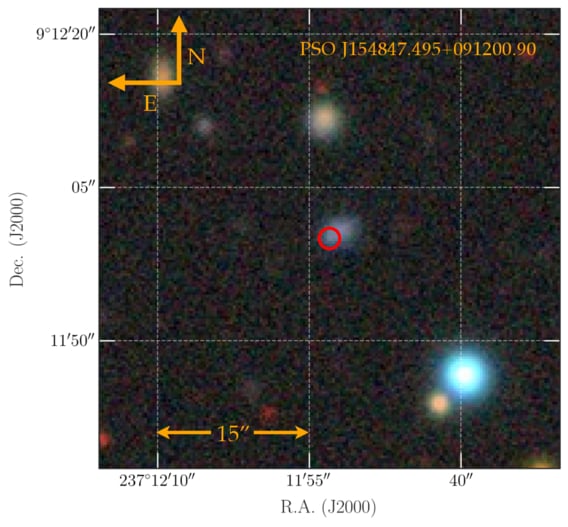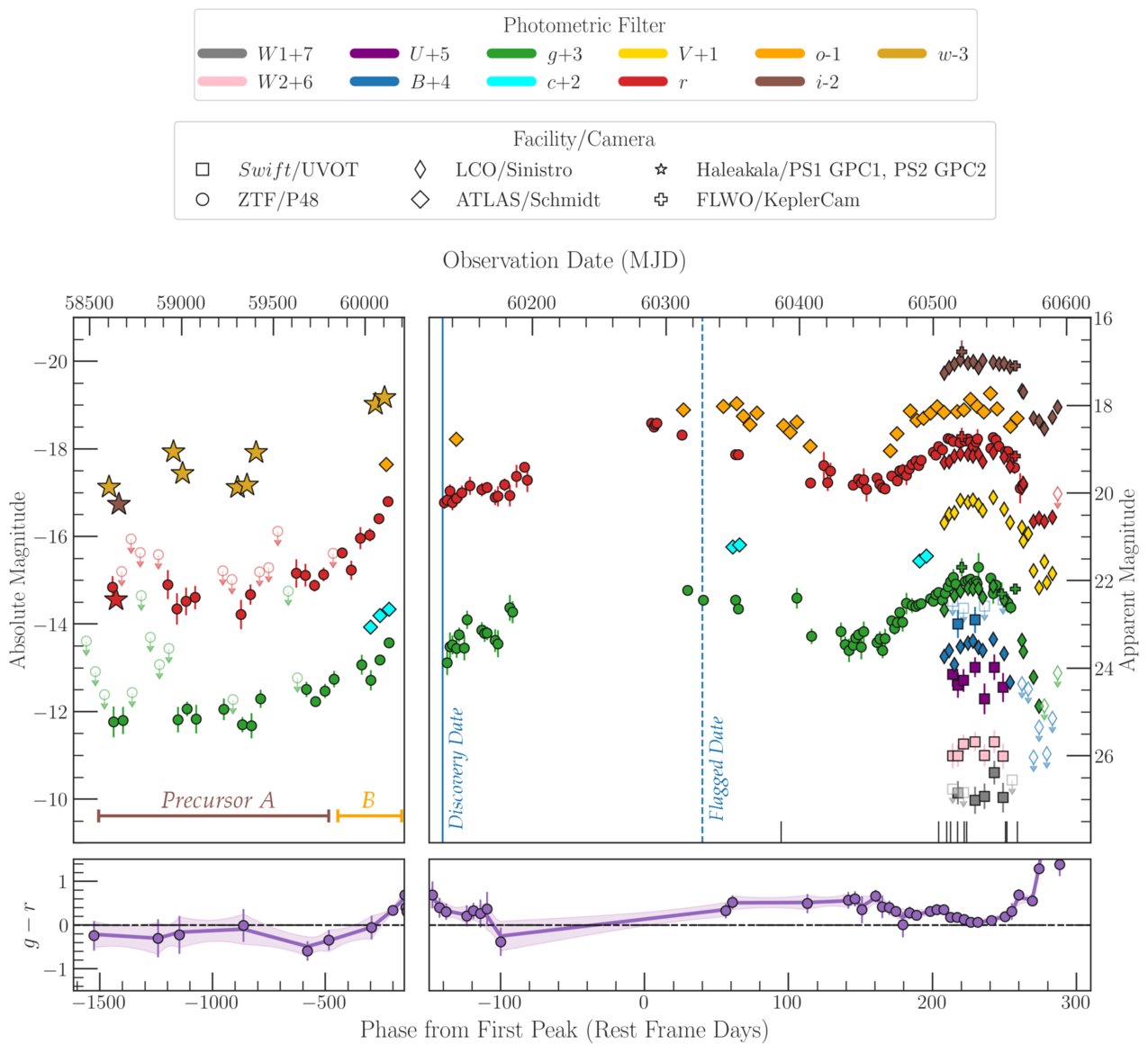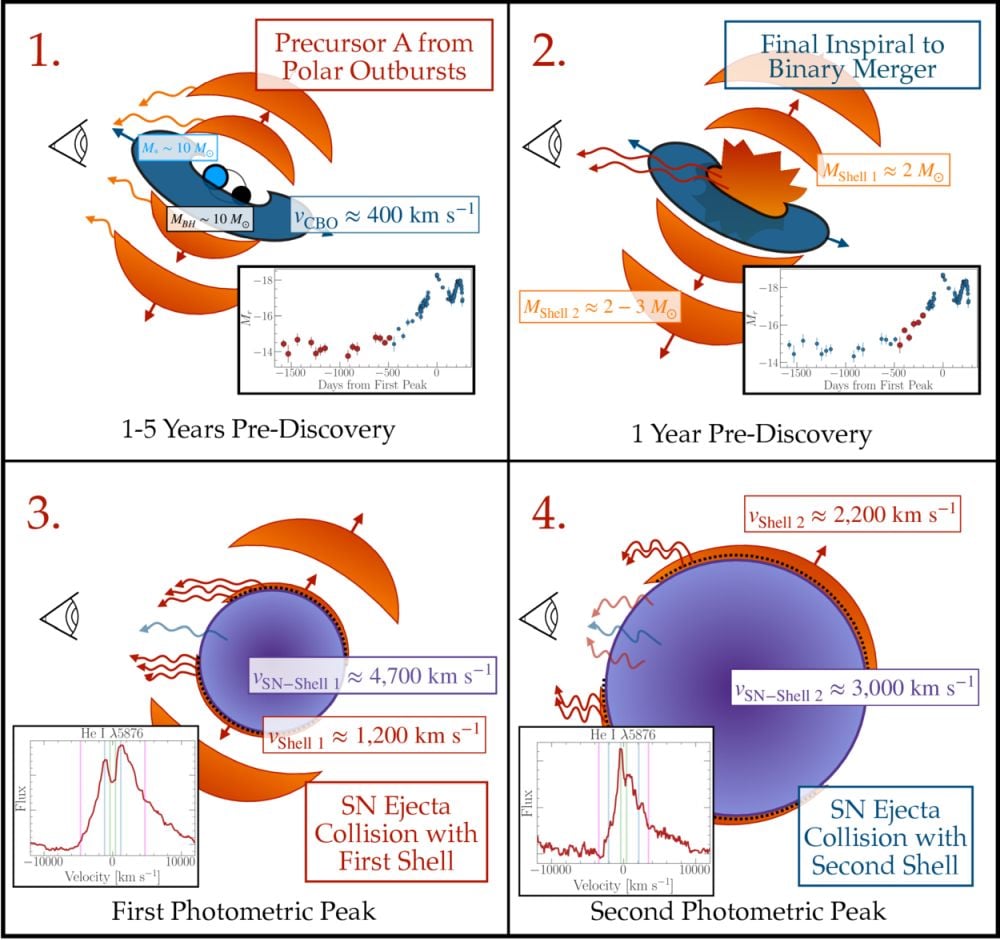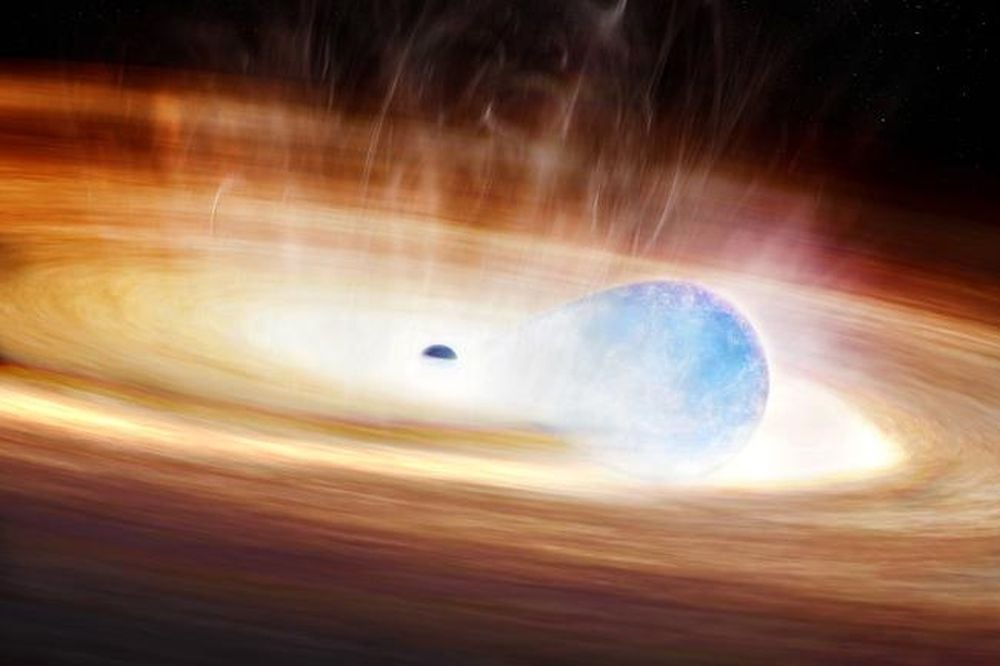Interactions between supernovae and black holes must be exceedingly rare. But that’s the only explanation for a very strange explosion found with the Zwicky Transient Facility. In July 2023, the ZTF spotted strange light signals about 730 million light-years from Earth, and AI helped astronomers unravel what they were seeing.
The ZTF scans the skies for transient objects that change in brightness. It’s an automated survey that sends out alerts when it detects something significant. The 2023 detection was made with a new artificial intelligence algorithm, and when it was detected, the ZTF alerted astronomers. Follow-up observations began quickly, which is critical because ongoing changes over time help astrophysicists understand what they’re seeing.
The blast received the name SN 2023zkd, and by the time it subsided, multiple telescopes had observed it.
Research in The Astrophysical Journal explains the detection and how astrophysicists determined what caused it. It’s titled “Evidence for an Instability-induced Binary Merger in the Double-peaked, Helium-rich Type IIn Supernova 2023zkd.” The lead author is Alexander Gagliano, a fellow at the NSF Institute for Artificial Intelligence and Fundamental Interactions.
 SN2023zkd is highlighted by the red circle. Its host galaxy is PS0 J154847.495+091200.90, about 815 million light-years away. Image Credit: Gagliardi et al. 2025. ApJ
SN2023zkd is highlighted by the red circle. Its host galaxy is PS0 J154847.495+091200.90, about 815 million light-years away. Image Credit: Gagliardi et al. 2025. ApJ
“We present ultraviolet to infrared observations of the extraordinary Type IIn supernova 2023zkd (SN 2023zkd),” the authors write. Archival data for the region exists for years before the SN discovery. They explain that the SN had persistent and luminous emissions for about 4 years preceding its discovery, and then a subsequent stage of gradual brightening in its final year. It also exhibited two similar brightness peaks after it was discovered, separated by about 240 days.
 This figure presents the photometry for SN2023zkd from multiple telescopes and observatories. “The data reveal both long-lived precursor emission and two pronounced post-explosion peaks,” the authors write. The gap in observations is seasonal when the Sun prevented observations. The light curve rose for 62 days following discovery, brightened after reappearing from behind the Sun, then declined for 170 days. 85 days after first minimum, it brightened dramatically. Another dimming period occurred before passing behind the Sun again. Image Credit: Gagliardi et al. 2025. ApJ
This figure presents the photometry for SN2023zkd from multiple telescopes and observatories. “The data reveal both long-lived precursor emission and two pronounced post-explosion peaks,” the authors write. The gap in observations is seasonal when the Sun prevented observations. The light curve rose for 62 days following discovery, brightened after reappearing from behind the Sun, then declined for 170 days. 85 days after first minimum, it brightened dramatically. Another dimming period occurred before passing behind the Sun again. Image Credit: Gagliardi et al. 2025. ApJ
The long-term rise in brightness prior to exploding is not normal for a supernova.
The researchers considered several explanations for what they were seeing. One possibility was the core collapse of a single massive star. SN2023zkd exhibited signs of being either a luminous blue variable or a carbon-rich Wolf-Rayet star. Both are massive, evolved stars, both of which explode as supernovae, but ultimately neither was a strong match. They also considered the possibility that they were witnessing a hydrogen-rich Wolf-Rayet star transitioning to a luminous blue variable, but discarded that as well.
The researchers concluded that what they were most likely seeing was a binary-driven merger supernova. Prior to exploding, supernovae eject material into the space around them, and the researchers think that part of what they’re seeing is the SN’s blast wave slamming into some of this material, creating the first peak in light. The second, delayed peak was caused by a slower but longer lasting collision with a thick, disk-like cloud. That cloud, when considered with the star’s erratic pre-explosion behavior, is a strong indicator that the star was experiencing extreme gravitational stress. That stress came from a dense, massive companion, a black hole.
“Our analysis shows that the blast was sparked by a catastrophic encounter with a black hole companion, and is the strongest evidence to date that such close interactions can actually detonate a star,” said lead author Gagliano in a press release. “Our machine learning system flagged SN 2023zkd months before its most unusual behavior, which gave us ample time to secure the critical observations needed to unravel this extraordinary explosion.”
The researchers also considered that the black hole completely destroyed the star before it could explode, and that when the debris fell into the black hole’s accretion disk, it generated the supernova-like emissions. In both cases, a black hole is left behind.
“2023zkd shows some of the clearest signs we’ve seen of a massive star interacting with a companion in the years before explosion,” said co-author V. Ashley Villar. Villar is a CfA assistant professor of astronomy in the Harvard Faculty of Arts and Sciences. “We think this might be part of a whole class of hidden explosions that AI will help us discover.”
 This image explains how the binary system associated with SN2023zkd evolved. First, between 1 to 5 years pre-discovery, two polar pre-merger outbursts that each eject ∼2 solar masses from the system created the detected photometric variability. During the final year pre-discovery, runaway accretion leads to a tightening of the binary, emitting the early photometric rise. This is because of either increased accretion onto the black hole or an outburst from the star. Next is the first photometric peak, when the primary star merges with the black hole and explodes. The ejecta smashes into the first He-rich polar shell creating the first peak. Lastly, interactions with the second polar shell create the second light curve peak, before the SN interaction shell reaches the edge of the outer polar material and quickly dims. Image Credit: Gagliardi et al. 2025. ApJ
This image explains how the binary system associated with SN2023zkd evolved. First, between 1 to 5 years pre-discovery, two polar pre-merger outbursts that each eject ∼2 solar masses from the system created the detected photometric variability. During the final year pre-discovery, runaway accretion leads to a tightening of the binary, emitting the early photometric rise. This is because of either increased accretion onto the black hole or an outburst from the star. Next is the first photometric peak, when the primary star merges with the black hole and explodes. The ejecta smashes into the first He-rich polar shell creating the first peak. Lastly, interactions with the second polar shell create the second light curve peak, before the SN interaction shell reaches the edge of the outer polar material and quickly dims. Image Credit: Gagliardi et al. 2025. ApJ
The authors explain that the observed properties suggest a merger-driven explosion between a 30 solar-mass star and a 10 solar mass black hole. The explosion follows years of unstable mass transfer. There are still some questions around the details of this merger and explosion.
“We advocate for continued multiwavelength monitoring of this explosion to further constrain the properties of the circumstellar matter and confirm both a core-collapse explosion and a binary origin,” the authors write. “Photometric samples of SNe IIn will dramatically increase in 2025, with the advent of the Vera C. Rubin Observatory’s Legacy Survey for Space and Time expected to discover ∼ 100,000 per year.”
“This discovery shows how important it is to study how massive stars interact with companions as they approach the end of their lives,” said Gagliano. “We’ve known for some time that most massive stars are in binaries, but catching one in the act of exchanging mass shortly before it explodes is incredibly rare.”
The Vera Rubin Observatory will search for supernovae in the night sky, and AI will be a part of the search. AI will process images in real time and detect and classify transients in the massive amount of data generated during its Legacy Survey of Space and Time. The Pan-STAARS will also be a part of the search, and will also use AI. The result should be a cascade of detections and follow-up study. “Algorithms designed to flag these long-lived and re-brightening transients will play a critical role in characterizing the full breadth of strongly interacting events,” the researchers conclude in their paper.
“We’re now entering an era where we can automatically catch these rare events as they happen, not just after the fact,” said Gagliano. “That means we can finally start connecting the dots between how a star lives and how it dies, and that’s incredibly exciting.”
